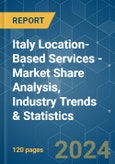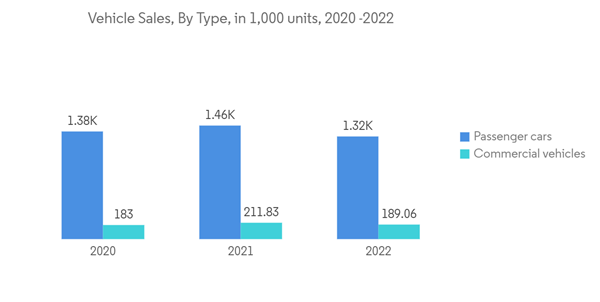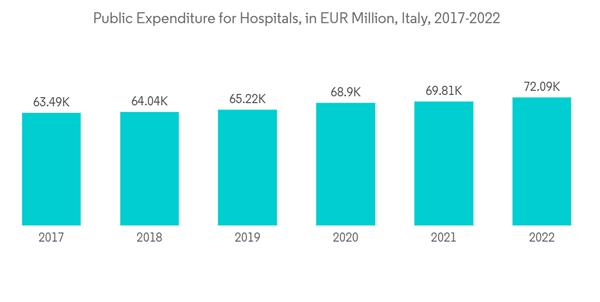The Italy location-based services market is valued at USD 0.44 billion in the current year. It is expected to register a CAGR of 12.86% during the forecast period to become 0.80 billion by the next five years.
In February 2023, Ericsson expanded its portfolio for indoor smartphone connectivity with the introduction of three new, cost-effective solutions designed to deliver comprehensive 5G coverage, capacity, and capabilities within various work or corporate environments. These solutions are adaptable to buildings of any size or complexity, and they seamlessly integrate into the Ericsson Radio Dot System portfolio, thereby enhancing the flexibility of this industry-leading range. This is a significant advancement given that approximately 80 percent of mobile data is consumed indoors, making robust indoor mobile connectivity a critical component of digital infrastructure.
In February 2023, Here Technologies, a prominent provider of location data and technology solutions, announced a strategic collaboration with Cognizant, a leading professional services firm. This partnership aims to provide real-time location insights and analytics to Cognizant's clients across diverse sectors, including retail, ride-hailing, logistics, manufacturing, and automotive industries. Leveraging these location-based insights and analytics, businesses can significantly improve their ability to precisely target and serve their customers, ultimately enhancing their operational efficiency and customer satisfaction.
This product will be delivered within 2 business days.
Key Highlights
- The location-based services (LBS) have emerged significantly during the past few years. It is used for locating friends in an area, locating the nearest restaurant, or advertising sales to shoppers nearby. Location-based services give users access to relevant and up-to-date knowledge about their surroundings and allow businesses to update their customers regarding their orders.
- Location-based advertising primarily uses the location data provided by the customers to send them timely and relevant advertisements from multiple brands. This type of marketing shows better promise and helps brands generate rich campaign engagement. It also drives valuable insights based on customer behavior. In the current market scenario, most customers carry a smartphone and most freely share their location data through the apps they use. This is where marketers get an enormous opportunity to pitch their ads based on real-time mobile location data. Geofencing, geo-conquesting, and hyperlocal marketing are emerging as the most significant trends in the market. This is primarily a targeting strategy that ad designers are using.
- Location-based services primarily help optimize vehicle routing and real-time route progress tracking. They also help in reducing fuel costs by providing the most optimized route. Big Data analytics can combine fleet, sensor, and geolocation data to pre-compute the potential risks and send early warnings to drivers. For example, an app on-board a vehicle can push a data-driven alert and offer informed recommendations to the driver (for instance, to slow down as the driver approaches a dangerous curve).
- In transportation, these services are also used for location-based information services, which include the localization of speed cameras, available parking spots, traffic alerts, and dynamic weather updates. Autonomous vehicles are gaining significant traction, with various multinational companies making strides in developing the required technologies. Many companies have also been identified as following this trend, which is expected to drive the adoption of autonomous vehicles over the studied period. Additionally, multinational technological firms, like Facebook, Apple Inc., Alphabet Inc., and Amazon, have been identified as spending heavily on the development of AI-powered cars, thus further propelling the market growth.
- On the contrary, Location-based services are revolutionizing various businesses where resource efficiency is crucial. Individuals' positions may be tracked at all times, and LBS gives the visibility needed to keep people safe. As a result, data security and privacy become increasingly important for users, as misuse might result in disastrous consequences. The frequency of data breaches has risen considerably in recent years due to various applications defying restrictions to gain access to a user's location without their authorization.
- Across Italy, the repercussions of the COVID-19 crisis were immense and unusual. Many auto-retail stores had stayed closed for a month or more, resulting in a decline in profit by the automotive manufacturer, reaching levels not seen in the last two years. It was anticipated that it would take years to recover from this plunge in profitability. The automotive sector, one of the largest benefactors of the LBS market, has experienced a significant impact driven by the COVID-19 pandemic.
Italy Location-Based Services Market Trends
Outdoor Segment is Expected to Hold Significant Share
- Outdoor positioning capabilities require regional or global coverage. Thus, global navigation satellite systems (GNSS), such as GPS, have been adopted in various applications, such as machine control, multi-modal transport navigation and guidance, synchronization of telecommunications networks, and asset management systems.
- Location-based marketing or geofencing is the most dominant use case in outdoor location-based services (LBS), where personalized content is sent to the user depending on their proximity to a particular location. This helps offline retailers have the same capability as their online counterparts in providing recommendations to users.
- Apps can use geofencing to actively guide their users to their exact location and deliver products and services more effectively by optimizing process delivery (Like ride-hailing services or food delivery platforms). Public transport apps can use geofencing to send general information alerts to consumers, informing them about active changes in the transit system, downtimes, and special announcements near a public transport hub. Apps, such as Google Maps and Waze, inform users of the best routes from their current location, toll payment for road users, and unordinary situations, like heavier-than-usual traffic jams and roadblocks.
- GNSS is the primary technology utilized by outdoor LBS for navigation purposes. According to the Global Positioning System, there are 30 operational satellites in the GPS constellation, which is expected to increase in the coming years. This would improve the error margin and consequently result in better positioning accuracies. However, GNSS doesn't perform well in cluttered buildings, close to walls, indoors, and underground environments, which is one of the market challenges. The studied segment can be noted as moving towards hybrid positioning, which integrates outdoor and indoor location-based services. The hybrid positioning technology is expected to gain significant traction as it enables users to have a seamless indoor and outdoor navigation experience.
- Location-based social networking is basically a convergence between a location-based service and online social networking. Applications, such as Google Maps, allow people to share information regarding their locations, thus making locative social media possible. Based on GPS, location-based social networking primarily uses smartphones that allow users to let large circles of people know where they currently are. Currently, location-based services have become a part of the rapidly growing sectors of the digital world. They are changing the ways in which people explore their lives.
- LBS helps integrate users with vehicle routes, stops, and driver schedules. An alert is triggered if the vehicle stops at an unregistered location or uses an unknown route. According to OICA (Organisation Internationale des Constructeurs d'Automobiles (French)The International Organization of Motor Vehicle Manufacturers), in 2022, Italy's auto industry sold nearly 1.51 million motor vehicles, 87.45 percent of which were passenger cars. Total new vehicle registrations in the country had dropped by 9.8 percent year-over-year due to decreased sales across categories. However, Italy remained the fourth largest vehicle market in Europe in 2022.
Healthcare is Expected to Hold Significant Share of the Market
- Wayfinding, asset tracking, and patient tracking are some of the most popular location-based services, allowing healthcare facilities to satisfy the requirements of patients and their homes while improving the quality of care and operating efficiency. Health service and information providers can react immediately to the varied location of a mobile user by conveying personalized, timely information and services for the user's new roaming region.
- With the help of indoor mapping and navigation products, patients can be assisted in making their way to and through any healthcare facility. Real-time information can be conveyed to the patients depending on where they are in the hospital, allowing them to make appointments on time and find the correct testing area. Patient tracking is essential for more vulnerable patients, such as people with Alzheimer's or younger children. Patients can be discovered immediately in an emergency to deliver care faster and more efficiently.
- An online healthcare facility locator service can help users discover the nearest hospital or clinic based on their location and healthiness needs and even supply them with operating directions and real-time traffic information. Location-based technologies, such as LogicJunction, play a key role in mHealth initiatives since they provide rich data, improve patient engagement, create opportunities for greater personalization of the healthcare experience, and seamlessly connect people, places, and things. MediNav Navigator v. 2.0 is one of the most popular indoor navigation solutions available for hospitals, with features like accurate turn-by-turn indoor navigation, parking planner, and network-wide wayfinding.
- The growing popularity of cloud-based Big Data analytics is one of the trends gaining traction in the market studied. Big Data analytics provide enriching insights into consumer buying patterns so that retailers can grow their sales volume and enhance customer search experiences. Location-as-a-service companies, such as GeoSpice, use big data analytics for offering cloud-based web services and mobile LBS, which can integrate real-time location information and data analytics.
- According to Istat, Public healthcare expenditure for hospitals in Italy increased overall in the last few years. The lowest value recorded throughout the period considered was in 2013, when public expenditure for hospitals amounted to barely EUR 61 billion USD 71.78 billion). In the following years, public funding increased steadily, reaching over EUR 72 billion (USD 84.96 billion) in 2022. The latter include physician, nursing, and other health services to inpatients, as well as the specialized accommodation services required by inpatients, which may also provide daycare, outpatient, and home healthcare services. Such huge healthcare expenditure would create an opportunity for the studied market.
Italy Location-Based Services Industry Overview
The Italy location-based services (LBS) market demonstrates a moderate level of consolidation, with several key players dominating the landscape. Notable industry leaders in this space include ALE International (a division of Nokia Corporation), Cisco Systems Inc. (Cisco Meraki), Ericsson Inc., Esri Inc., and Aruba Networks (a subsidiary of HPE Development LP). These companies are actively pursuing strategic partnerships and product development initiatives to expand their market presence. Noteworthy recent developments in the market include:In February 2023, Ericsson expanded its portfolio for indoor smartphone connectivity with the introduction of three new, cost-effective solutions designed to deliver comprehensive 5G coverage, capacity, and capabilities within various work or corporate environments. These solutions are adaptable to buildings of any size or complexity, and they seamlessly integrate into the Ericsson Radio Dot System portfolio, thereby enhancing the flexibility of this industry-leading range. This is a significant advancement given that approximately 80 percent of mobile data is consumed indoors, making robust indoor mobile connectivity a critical component of digital infrastructure.
In February 2023, Here Technologies, a prominent provider of location data and technology solutions, announced a strategic collaboration with Cognizant, a leading professional services firm. This partnership aims to provide real-time location insights and analytics to Cognizant's clients across diverse sectors, including retail, ride-hailing, logistics, manufacturing, and automotive industries. Leveraging these location-based insights and analytics, businesses can significantly improve their ability to precisely target and serve their customers, ultimately enhancing their operational efficiency and customer satisfaction.
Additional Benefits:
- The market estimate (ME) sheet in Excel format
- 3 months of analyst support
This product will be delivered within 2 business days.
Table of Contents
1 INTRODUCTION
4 MARKET INSIGHTS
5 MARKET DYNAMICS
6 MARKET SEGMENTATION
7 COMPETITIVE LANDSCAPE
Methodology

LOADING...










